Skiing in Cortina d'Ampezzo
Cortina d’Ampezzo ski area consists of four very distinct areas – Faloria-Cristallo-Mietres; Tofana-Socrepes; Lagazuoi and Cinque Torri – each offering a radically different ski experience, from skiing below the tree line, via couloirs to rolling, twisting pistes.
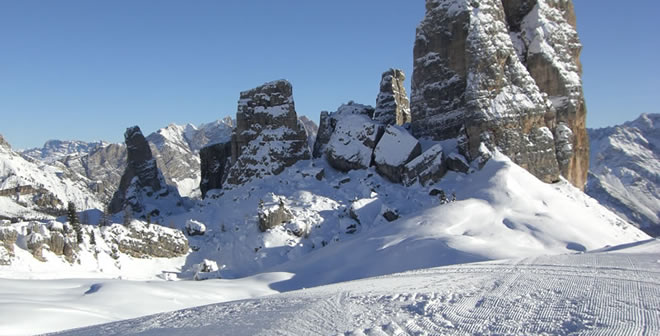
Cortina d’Ampezzo Ski Area Overview
A glance in any direction from Cortina d’Ampezzo tells you these are big mountains. Maximum vertical drop on piste is an impressive 1,715m from 2,939m on Staunies in the Cristallo region to 1,224mt at town level, but that’s the exception rather than the rule, with most descents extending for no more than half that amount – a function of the extreme shape of the peaks, which are rocky cliffs for much of their height.
Almost two thirds of Cortina’s 101 ski pistes are red runs for intermediates and one-third are beginner-friendly blue runs with just a handful of challenging black runs suitable for advanced skiers only. The modest total of 120km (which feels like more, thanks to the diversity of runs and broad geographical spread) is served by 51 lifts: 6 cable cars and 29 chair lifts give ample capacity of over 55,000 people per hour; most of the pisted area is covered by snow-making.
The four main areas – Faloria-Cristallo-Mietres; Tofana-Socrepes; Lagazuoi and Cinque Torri – are connected either by ski lift or a skibus service. Few other major ski resorts have skiing spread round such a large valley – Chamonix may be the closest parallel to Cortina, though the resorts could hardly be more different in all other respects. Though lacking on-ski connectivity, the ski areas are at least well-mapped on the standard piste map to allow you to plan your time on snow well: one side has a scenic depiction, making the most of the distinctive peaks; the other has a schematic plan view. It’s refreshing to be able to establish where in the world you are with relative ease and also rewarding – the most mountain-blind visitor wants to know which peak is which when they look as unique as this.
The defining factor is that each separate area is topographically very distinct from its neighbours, giving a radically different ski experience from one place to the next and offering opportunities for skiing below the tree line, one or two couloirs, and rolling, twisting piste elsewhere. There’s also significant variety of elevation; with the areas spread to east and west of town, and with varied aspects, these are all factors which combine to create very different snow conditions across the resort during the course of the day. In low season it’s easy to drive between areas but the bus system is also effective and the only option unless you’re visiting by car.
Faloria-Cristallo-Mietres
Starting from the outskirts of town, Faloria is accessed by a two stage cable car that soars above heavily forested slopes and a rocky escarpment to the east of town. The skiing here is hidden from Cortina, on north facing slopes that descend to Rio Gere where they are divided by road from Cristallo and a dramatic chairlift rising to 3000m between the tight walls of a couloir for the steepest, blackest run in the resort at Staunies. Both Cristallo and Faloria are also accessed by bus or car from the point where they meet on the Passo Tre Croci road. Also on this side of town, to the north east is the small two-lift blue run area of Mietres.
Tofana-Socrepes
To the west of town, the high Tofana region reaches nearly 3000m and connects to the lower Rumerlo and Socrepes area, but only by a black run. Access is from the outskirts of town by the Col Druscie cable car or by car or bus to the top station of this lift – a preferable option when snow on the single blue run back to base is scarce. The Socrepes area is best reached from the car parks at Lacedel.
Cinque Torri and Lagazuoi
The road continues to the two furthest outlying areas: Cinque Torri and Lagazuoi are both small but one-way linked by a green run. From the pass at Falzarego a remarkable cable car climbs to Lagazuoi and the option of the 8.5km Armentarola run to the far side of the mountains through Vallon Lagazuoi and a return by bus or taxi from Armentarola in Val Badia; the run is rightly famous for its opportunity to ski through a high, remote valley of great beauty.
Beginner Skiing in Cortina d’Ampezzo
Cortina has excellent beginner runs at Socrepes. Moreover, the breathtaking mountains, wonderful refuges and classy town compensate for sweat and bruises.
There are excellent beginner runs at Socrepes, at reasonable altitude and lots of them, along with great slopes to progress to. Whether first-timers will enjoy getting on a bus to ski, or cope with the exuberant high speed Italian antics of other skiers is another question, but other aspects of the experience – the breathtaking mountains, wonderful refuges and classy town – should be sufficiently inspiring to make this a great first trip on skis.
Ski Schools & Ski Lessons in Cortina d’Ampezzo
Looking for private or group ski lessons in Cortina? CheckYeti works with leading ski schools and ski instructors in over 500 ski destinations throughout Austria, France, Germany, Italy and Switzerland. Let them help you choose the right ski school or instructor for you. Qualified and experienced ski instructors and guides at 500+ ski destinations, 6,000+ offers and 24,000+ ski school reviews. View ski schools, classes, offers and discounts, and pre-book your ski lessons online.
Book Ski School Lessons in Cortina Online >
Intermediate Skiing in Cortina d’Ampezzo
Cortina could be heaven for intermediates: there’s no corner you can’t discover enjoyably, although the four different ski areas are fragmented.
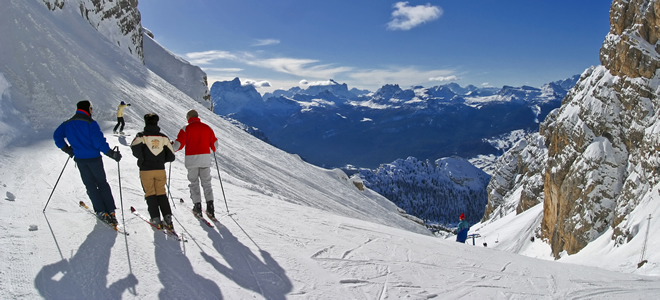
©bandion.it
Cortina could be heaven for the vast majority of skiers. With few terrors to lose sleep over and appropriate terrain spread evenly throughout all the individual ski areas, there’s no corner you can’t discover enjoyably. With the exception of Staunies (just one run, out on a limb) and possibly the Forcella Rossa (which you will want to brave to link two areas), there’s nowhere you can’t go. That’s particularly useful in Cortina, both to experience the variety of view and terrain and to provide the mileage for the week.
Highlights for this ski level are too numerous to mention. Don’t be put off by the credentials of the Olimpia, where the Women’s World Cup downhill race takes place every year, flying past a huge outcrop of rock whose massive vertical face overshadows a steep section of the course. Equally, the long excursion to Armentarola should be on your list for a fine day.
The one drawback of Cortina for serious piste-bashers is that the areas are fragmented but the relative lack of vertical common to much of the Dolomites is not a real problem here, and there are notable long descents, such as the 1600m from Tofana back to town. The Dolomiti Superski pass is likely to appeal to adventurous intermediates too – not just Cortina and adjacent areas are covered, but all 1200km of piste in the Dolomites, much of it easily reached by car for the day.
Advanced & Expert Skiing in Cortina d’Ampezzo
Challenging ski terrain is not Cortina’s strongest suit, but there are a number of good blacks, some hidden off-piste to get the juices flowing as well as wonderful – and luxurious – ski touring.
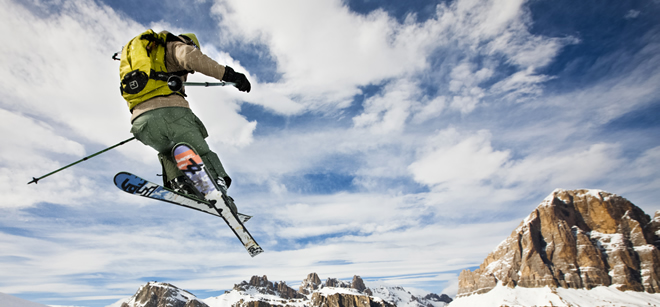
© D G Bandion
Being Italy, the grooming and snow-making tends to be excellent and the lack of overcrowding allows many of the rolling, twisting red runs to be taken at exhilarating speed. There are also several black runs of note: the Canalone Staunies, the steepest piste in the Dolomites, between tight, imposing rock walls; a couple above Faloria; and three more on Tofana, including the classic Forcella Rossa.
Off-piste there are opportunities too, though they’re not obvious, with little of interest between the piste and some of the best stuff hidden in steep couloirs. Local guides will take you down the Creste Bianche, Bus Tofana, Canalino del Prete and Sci 18. The website www.dolomiti.org has excellent pages detailing some of the many possibilities, with pictures and maps.
Maybe the highlight, if you’re willing to sweat a bit, is to ski tour, based at the refuge at Fanes. More like a four star hotel than a mountain hut, there are en suite rooms available as well as dorms, beautiful facilities and wonderful dining with oodles of atmosphere, history and natural beauty.
Boarding & Freestyle in Cortina d’Ampezzo
Cortina’s limited off-piste and good grooming make it a good place for carvers rather than free riders. There is also a terrain park at Faloria.
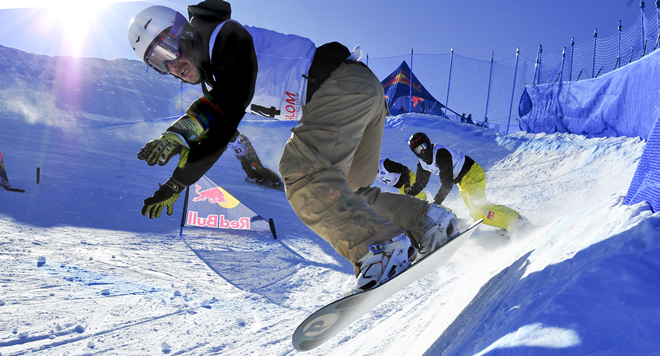
©stefanozardini.com
The pisted terrain is mostly as good to board as to ski, with generally few flats although some link-runs are bad news. Limited off piste and good grooming make this a place for carvers. The lift system still includes significant numbers of older 2-seater chairlifts, which may cause difficulty for some snowboarders, but mostly Cortina’s ski lifts are adequate.
Cortina’s 500m long snowpark at Faloria, reached by a 4-seater chairlift from Socrepes, includes an easy line for children and beginners with four kickers of varying length from 1-6 metres, ground-level box and rail. More experienced boarders and freestylers can ride the medium line with super box kink 4 metres flat and 4 metres descent, t box and tube rail (3 metres each), bank bins, wall ride 3×2, tree bank with rail, kicker and fun box 8-10 metres. Helmets are compulsory.
Mountain Restaurants in Cortina d’Ampezzo
Cortina d’Ampezzo has plenty of mountain restaurants and is famous for its mountain refuges. Good food is as predictable as good views across all four ski areas in Cortina, and affordable.,
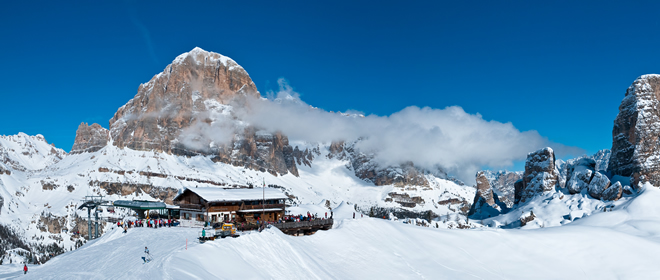
©giuseppeghedina.com
A definite highlight: Cortina is famous for its mountain refuges. Most of these cater to summer mountaineers and walkers, but those that fall within the ski area also do a roaring winter trade. There are over 30 refuges and restaurants that can be reached on piste; many of them can also be accessed by car and on foot, so that even when the pistes are deserted all day, the sundecks can be swarming. You should certainly book for lunch at weekends. Good views are as predictable as good food across all the areas. Cinque Torri and Socrepes both score highly, but even big places such as the Rifugio Faloria keep the quality high despite the volume.
Pista Bar Pian de ra Bigontina
Situated at the base of Mount Faloria, Bigontina provides a chance to refuel and catch up with any others who may have been left behind you on the run down Faloria. It’s not just the location that makes this a worthwhile meeting point – service is typically quick, there is a pleasant ambience and the Gaspari family’s sausage & frankfurter sandwiches hit the spot between trips up the mountain.
Tel: +39 338 5265725, Email: [email protected]
Rifugio Averau
If you’re skiing Cortina, the multi-award winning Rifugio Averau should be high up on your list of lunchtime destinations. Dubbed the ‘Restaurant at the Edge of the Universe’, Rifugio Averau offers stunning panoramic views of the Dolomite landscape – a fact not lost on the Sunday Times who have named this as one of the ten best mountain restaurants in the Alps. The breathtaking views make the terrace an ideal spot for an open air lunch, and there is food to match, with hosts Paola and Sandro well known for their fine cuisine. There is a cosy feel indoors, with the option of dinner as well as lunch, and the refuges provide the option of an overnight stay – popular in both summer and winter – with double rooms or dorms available. Web: www.lagazuoi5torri.dolomiti.org
Tel: +39 0436 4660. Email: [email protected]
Rifugio Capanna Tondi
Rifugio Capanna Tondi is a good option for those skiing on Mount Faloria. The traditional decor and range of local dishes makes Tondi a deserving lunchtime contender, while the large sun terrace means this is an equally good spot for a quick outdoor drink. Its location at the top of the Vitelli chair means Tondi can be busy at peak times, so you may wish to book ahead if you have a large group wishing to eat. There is also the option of spending at atmospheric evening at Tondi, with a number of local traditional dishes to choose from, and the option of being guided back to town by the staff either by ski or snowmobile. Web: www.cortinadampezzo.it/virtualtour/rifugiotondI
Tel: +39 0436 5775. Email: [email protected].
Ristorante Rifugio Col Drusciè
With spectacular scenery and excellent food, the Rifugio Col Drusciè is one of Ultimate-Ski’s Cortina favourites. The Col Drusciè is not alone in Cortina in offering stunning views – although at 1,778m it does boast some of the best views of the Dolomites and the Ampezzo valley from its large terrace – but not many mountain restaurants can match the pride the Col Drusciè takes in its food. Prepare yourself for a feast to start as the Tirolean plate brings you a gigantic mix of ham and salami, before an appetising range of steaks and burgers for your main. Staff are welcoming and charming, helping the Col Drusciè to stand out above the rest. Web: www.freccianelcielo.com
Tel: +39 0436 862372. Email: [email protected].
Rifugio Col Gallina
Situated beneath the imposing peaks of Cortina, the Rifugio Col Gallina can be found 5 minutes from the Torri chairlift and Lagazuoi cable cars. Its large field, swings and slides makes it a worthwhile option for families with children, while there is a schedule of live entertainment, themed parties and buffets throughout the year. While the Col Gallina’s large balcony faces the ski slopes, it is arguably more popular during the summer months, offering an ideal starting point for mountain bikers. Web: www.lagazuoi5torri.dolomiti.org
Tel: +39 0436 2939. Email: [email protected].
Rifugio Duca d’Aosta
Those of you seeking a substantial meal will not be disappointed by the Rifugio Duca d’Aosta. Situated in the Tofane region, there are several meat dishes on offer and a good choice of deserts, giving you an extra reason to enjoy the stunning views of the Ampezzo Valley. The Duca d’Aosta is open throughout the year, with the balcony offering a memorable scenic setting during the summer months. Web: www.cortinadampezzo.it/ducadaosta
Tel: +39 0436 2780. Email: [email protected].
Rifugio Faloria
The Rifugio Falori’s excellent cuisine including many local specialities means the large reception hall is often full when the locals come to town. Situated at the start of the Faloria cable car, the Rifugio Faloria also offers overnight accommodation in comfortable rooms and a total of 25 beds making this an option for large groups looking for a mountain hideaway with splendid views from the large sun terrace overlooking the Cortina valley.
Tel: +39 0436 2737
Rifugio Lagazuoi
At an altitude of 2,752m, the Rifugio Lagazuoi is one of Cortina’s highest mountain refuges, offering famous views over the stunning Dolomite landscape. Photographers from numerous magazines both in Italy and abroad have taken advantage of the views offered by the Lagazuoi’s popular balcony, while its location makes it a favourite for skiers and trekkers wishing to make an early start. While the views are hard to beat, the cuisine is also worthy of mention, with a pleasingly authentic feel. Top tips from the menu include polenta with deer and barley soup and the “kaiserschmarren” dessert is not to be missed. Web: www.lagazuoi5torri.dolomiti.org
Tel: +39 0436 867303. Email: [email protected].
Rifugio Lago d’Ajal
Situated by Lake d’Ajal, both the setting and the food make Rifugio Lago d’Ajal a family favourite. The beef bourguignon with homemade sauce comes highly recommended, and the choice of desserts include mousses, bavarese ice-cream cake and panna cotta. While easily accessible during the summer, it is arguably the winter-time journey to the Rifugio – by snowcat or snowmobile – which together with good cuisine and great ambience makes for a most memorable visit.
Mob: +39 368 944299. Email: [email protected].
Rifugio Pomedes
As with many of Cortina’s mountain restaurants, the Rifugio Pomedes offers breathtaking views of the Dolomites, though few can match Pomedes for views of the ‘Alpenglow’. Once the sun dips just below the horizon, Pomedes offers memorable views of the sun-struck Dolomites, with golden-red illuminations. The Ghedina family’s authentic menu is equally enjoyable, with a good choice of meals and the customary grappa to round things off. Web: www.rifugiopomedes.dolomiti.org
Tel: +39 0436 862061. Email: [email protected].
Rifugio Ra Stua
A favourite among skiers and walkers, the Rifugio Ra Stua’s location in the Natural Park of the Dolomites makes it a popular destination all year round. ‘Lucabeca’s management ensures a personal feel to Ra Stua, and the food reflects this. The ‘tagliatelle alla Ra Stua’ is worthy of recommendation, and it’s just as well that visitors to Ra Stua tend to have an active break, because the selection of deserts are not to be missed.
Tel: +39 0436 5753. Mob: +39 348 7617388
Rifugio Scoiattoli
With so many of Cortina’s mountain restaurants offering great views, you would do very badly not to find a stunning view to accompany your meal. However, the Rifugio Scoiattoli’s history gives it a twist – it was built by alpine guide Lorenzo Lorenzi who still runs the refuge with his family. Scoiattoli offers views over the 5 Torri area, and as well as a good choice of meaty dishes, there is the option for a wintertime evening experience, with the Lorenzi family inviting guests to reach the refuge by chairlift at night. Web: [email protected]
Tel: +39 0436 867939. Email: [email protected].
Rifugio Son Forca
This family run refuge has developed a reputation for good food, with the Siorpaes family serving up an appetizing selection of traditional Italian main courses. Another year-round destination, Son Forca is well located to enjoy the Dolomites while also serving up that authentic taste of Italy that many visitors crave.
Tel: +39 0436 861822 – 866192. Mob: +39 349 8800032











